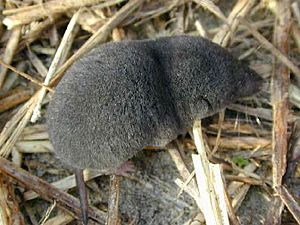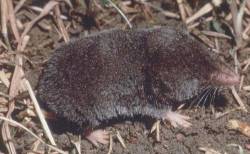Shrew facts for kids
Quick facts for kids ShrewsTemporal range:
middle Eocene to Recent |
|
|---|---|
 |
|
| A southern short-tailed shrew | |
| Scientific classification | |
| Kingdom: | |
| Phylum: | |
| Class: | |
| Infraclass: | |
| Order: | |
| Suborder: | |
| Family: |
Soricidae
|
| Subfamilies | |
|
|
Shrews are tiny, furry mammals that look a bit like moles or mice. They are part of a group of animals called Soricidae. Even though they might look like mice, shrews are not rodents. They are actually more closely related to moles!
You might hear about other animals with "shrew" in their name, like treeshrews or elephant shrews. But these are not "true shrews." True shrews belong to the Soricidae family.
Shrews have very sharp, pointy teeth, which are different from the front gnawing teeth that rodents have. They are found almost all over the world. The only places without native shrews are New Guinea, Australia, and New Zealand. In South America, shrews are newer arrivals and live mostly in the northern Andes mountains.
Contents
What Makes Shrews Special?
Most shrews are very small, often no bigger than a mouse. The largest shrew is the Asian house shrew, which can be about 15 centimeters (6 inches) long and weigh around 100 grams (3.5 ounces).
On the other hand, the Etruscan shrew is one of the smallest mammals on Earth! It's only about 3.5 centimeters (1.4 inches) long and weighs just 2 grams (0.07 ounces). That's lighter than a penny!
Shrew Habits and Diet
Shrews usually live on or in the ground. They are always busy looking for food like seeds, insects, nuts, and worms. Some shrews can climb trees, while others live underground or even under the snow. Some types of shrews can even hunt in water!
Shrews have small eyes and don't see very well. But they have amazing senses of hearing and smell. These senses help them find food and stay safe.
They are very active animals and need to eat a lot. Shrews have a very fast metabolic rate. This means their bodies burn energy quickly. Because of this, shrews usually eat 80–90% of their own body weight in food every single day!
How Shrews Survive Winter
Shrews do not hibernate like bears or some other animals. However, they can go into a state called torpor. This is like a short, deep sleep where their body temperature and metabolism slow down.
In winter, shrews can actually lose a lot of their body weight, sometimes 30% to 50%. Their bones, skull, and even internal organs can shrink in size. This helps them survive when food is scarce.
Shrew Teeth
Unlike rodents, whose front teeth keep growing throughout their lives, a shrew's teeth do not grow back. Shrews are born with their adult teeth and do not have baby teeth like humans do.
Their teeth wear down over time. Shrews have long, sharp front teeth (called incisors) and chewing teeth (molars) at the back of their mouths. The other teeth are small and peg-like.
See also
 In Spanish: Sorícidos para niños
In Spanish: Sorícidos para niños



